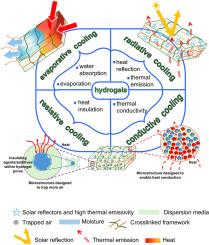推进绿色建筑被动辐射冷却技术:水凝胶的潜力和挑战
IF 16.3
1区 工程技术
Q1 ENERGY & FUELS
引用次数: 0
摘要
被动辐射冷却(PRC)技术因其提高能源效率、降低冷却成本和支持可持续发展目标的潜力而受到关注。最近的进展集中在提高冷却效率、耐用性和可扩展性的材料上。水凝胶由于其高含水量、三维(3D)多孔网络、生态友好以及有效的吸热和散热能力而被看好。它们可以显著减少空调能源需求,提高热舒适性,降低碳排放。水凝胶用于PRC的研究仍处于早期阶段,对其冷却原理和机理的研究综述有限。本文综述了水凝胶冷却的基本原理和机理,包括蒸发、吸水、辐射和保温。本文还提出了理论建模和设计水凝胶多孔结构以提高冷却效率的数学关联。综述强调了被动辐射冷却的核心概念,这对开发先进的冷却水凝胶至关重要。它还讨论了绿色建筑中基于水凝胶的PRC的最新创新,解决了扩大和提高耐久性方面的挑战,并为未来的研究提供了建议。通过展示这些进步,本综述旨在为开发节能和可持续的冷却解决方案做出贡献,最终支持全球脱碳努力。本文章由计算机程序翻译,如有差异,请以英文原文为准。

Advancing passive radiative cooling technology for green buildings: The potential and challenges of hydrogels
Passive radiative cooling (PRC) technology is gaining attention for its potential to enhance energy efficiency, reduce cooling costs, and support sustainability goals. Recent advancements have focused on materials that improve cooling efficiency, durability and scalability. Hydrogels are promising due to their high water content, three-dimensional (3D) porous network, eco-friendliness, and effective heat absorption and dissipation capabilities. They can significantly reduce air conditioning energy demand, improve thermal comfort and lower carbon emissions. Research on hydrogels for PRC is still in its early stages, with limited reviews available on their cooling principles and mechanisms. This review explores the fundamental principles and mechanisms of hydrogel cooling, including evaporation, water absorption, radiation, and thermal insulation. It also proposes mathematical correlations for theoretical modelling and designing hydrogel porous structures to enhance cooling efficiency. The review highlights the core concepts of passive radiative cooling, which are essential for developing advanced cooling hydrogels. It also discusses recent innovations in hydrogel-based PRC for green buildings, addresses challenges in scaling up and improving durability, and offers recommendations for future research. By showcasing these advancements, this review aims to contribute to developing energy-efficient and sustainable cooling solutions, ultimately supporting global decarbonization efforts.
求助全文
通过发布文献求助,成功后即可免费获取论文全文。
去求助
来源期刊

Renewable and Sustainable Energy Reviews
工程技术-能源与燃料
CiteScore
31.20
自引率
5.70%
发文量
1055
审稿时长
62 days
期刊介绍:
The mission of Renewable and Sustainable Energy Reviews is to disseminate the most compelling and pertinent critical insights in renewable and sustainable energy, fostering collaboration among the research community, private sector, and policy and decision makers. The journal aims to exchange challenges, solutions, innovative concepts, and technologies, contributing to sustainable development, the transition to a low-carbon future, and the attainment of emissions targets outlined by the United Nations Framework Convention on Climate Change.
Renewable and Sustainable Energy Reviews publishes a diverse range of content, including review papers, original research, case studies, and analyses of new technologies, all featuring a substantial review component such as critique, comparison, or analysis. Introducing a distinctive paper type, Expert Insights, the journal presents commissioned mini-reviews authored by field leaders, addressing topics of significant interest. Case studies undergo consideration only if they showcase the work's applicability to other regions or contribute valuable insights to the broader field of renewable and sustainable energy. Notably, a bibliographic or literature review lacking critical analysis is deemed unsuitable for publication.
 求助内容:
求助内容: 应助结果提醒方式:
应助结果提醒方式:


